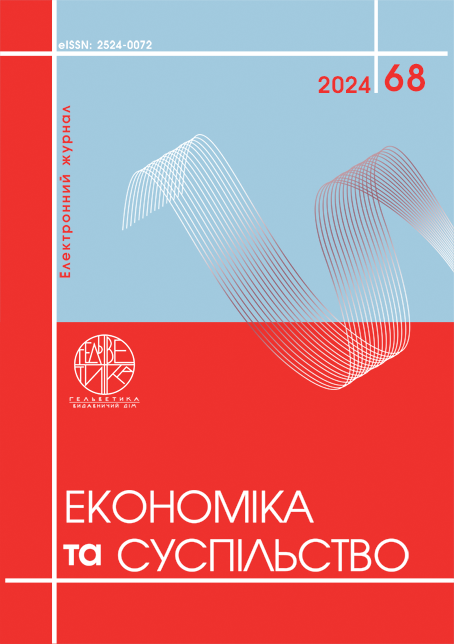CRYPTOCURRENCY IN INTERNATIONAL PAYMENTS
Abstract
The study of cryptocurrencies in the context of international payments is one of the most significant and relevant topics of modern economic science. In the context of rapid digitalization of the economy and globalization of international trade, cryptocurrencies have the potential to radically change approaches to financial transactions, simplify cross-border payments, and eliminate existing barriers in the international payment system. This article aims to explore the main aspects of the use of cryptocurrencies in international trade, their advantages and disadvantages compared to traditional financial systems, as well as the prospects and risks of their further spread in the global economy. Cryptocurrencies are a relatively new phenomenon in the financial world, with a history of just over a decade. The cryptocurrency era began with the emergence of bitcoin in 2009, which became the first decentralized digital currency based on blockchain technology. It was followed by cryptocurrencies such as Namecoin, Litecoin, PPCoin, and Novacoin, each with its own unique characteristics and applications. For example, Namecoin was originally created as a means of decentralized domain name registration, while Litecoin was designed to make transactions faster and cheaper than bitcoin. The evolution of cryptocurrencies has been accompanied by growing interest from individuals, companies and investors, which has led to the formation of the cryptocurrency market as a separate area of financial activity. However, decentralization of cryptocurrencies is also accompanied by a number of challenges, such as lack of centralized regulation, high risk of fraud, and difficulty in integrating cryptocurrency technologies into traditional financial systems. In addition, changes in legislation, regulators' actions, and market sentiment have a significant impact on the market, which makes analyzing the cryptocurrency market an important task for researchers and practitioners. Despite the existing risks and limitations, the prospects for the use of cryptocurrencies in international trade remain very promising. In particular, cryptocurrencies may become an important tool for facilitating cross-border payments, especially in the context of the digitalization of the economy and the growth of e-commerce. At the same time, an important aspect is the development of international standards and regulations governing the use of cryptocurrencies. This will minimize risks and protect the rights of market participants. In addition, cooperation between government agencies, financial institutions and technology companies can contribute to the creation of a safe and sustainable ecosystem for the use of cryptocurrencies in international settlements. For companies engaged in international trade, cryptocurrencies represent a promising tool to optimize financial operations and improve competitiveness. For financial institutions and regulators, the study of cryptocurrencies allows for a better understanding of existing risks and the development of measures to minimize them, which is especially important in the transition to a digital economy. In conclusion, the use of cryptocurrencies in international payments is a complex but promising topic that requires further study and development of approaches to its implementation in practice.
References
Бьоме, Р., Крістін, Н., Едельман, Б. та Мур, Т. (2015). Біткойн: економіка, технологія та управління. Економічні перспективи. URL: https://www.aeaweb.org/articles?id=10.1257/jep.29.2.213 (дата звернення: 07.09.2024).
Антонопулос, А. М. (2017). Освоєння Bitcoin: розблокування цифрових криптовалют. URL: https://books.google.com.ua/books/about/Mastering_Bitcoin.html?id=IXmrBQAAQBAJ&redir_esc=y (дата звернення: 12.09.2024).
Каталіні, К., та Ганс, Д. С. (2016). Деякі прості економічні аспекти блокчейну. URL: https://www.nber.org/system/files/working_papers/w22952/w22952.pdf (дата звернення: 11.09.2024).
Тихонов І., (2020) Огляд криптовалют URL : https://bits.media/bitcoin-forks/. (дата звернення: 11.09.2024).
Волосович С. В. Віртуальна валюта: глобалізаційні виклики та перспективи розвитку. Економіка України. 2016. № 4 (653). URL: http://nbuv.gov.ua/UJRN/ EkUk_2016_4_8 (дата звернення: 12.09.2024).
Світовий банк. (2020). Вплив цифрових фінансових послуг на економічне зростання. URL: https://pubdocs.worldbank.org/en/230281588169110691/Digital-Financial-Services.pdf (дата звернення: 07.09.2024).
Щодо віднесення операцій із «віртуальною» валютою – криптовалютою Bitcoin. лист Національного банку України від 8 груд. 2014 нар. №29-208/72889. URL: http://zakon3.rada.gov.ua/laws/show/v2889500-14 (дата звернення: 07.09.2024).
Банк міжнародних розрахунків (БМР) (2019). Річний економічний звіт БМР: Великі технології у фінансах. URL: https://www.thebankerdatabase.com/ (дата звернення: 08.09.2024).
Ауер, Р., та Клаессенс, С. (2018). Регулювання криптовалют: оцінка реакції ринку. URL: https://www.bis.org/publ/qtrpdf/r_qt1809f.htm (дата звернення: 11.09.2024).
Böhme, R., Christin, N., Edelman, B., & Moore, T. (2015) Bitcoin: Economics, technology, and governance. Journal of Economic Perspectives. Available at: https://www.aeaweb.org/articles?id=10.1257/jep.29.2.213 (accessed September 07, 2024).
Antonopoulos, A. M. (2017) Mastering Bitcoin: Unlocking Digital Cryptocurrencies. Available at: https://books.google.com.ua/books/about/Mastering_Bitcoin.html?id=IXmrBQAAQBAJ&redir_esc=y (accessed September 12, 2024).
Catalini, C., & Gans, J. S. (2016) Some Simple Economics of the Blockchain. NBER Working Paper No. 22952. Available at: https://www.nber.org/system/files/working_papers/w22952/w22952.pdf (accessed September 11, 2024).
Overview of cryptocurrencies. Available at: https://bits.media/bitcoin-forks/ (accessed September 11, 2024).
Virtual currency: globalization challenges and development prospects. Ekonomika Ukrainy. 2016. № 4 (653). Available at: http://nbuv.gov.ua/UJRN/EkUk_2016_4_8 (accessed September 12, 2024).
World Bank. (2020) The Impact of Digital Financial Services on Economic Growth. Available at: https://pubdocs.worldbank.org/en/230281588169110691/Digital-Financial-Services.pdf (accessed September 07, 2024).
Letter of the National Bank of Ukraine of December 8, 2014, No. 29-208/72889. Available at: http://zakon3.rada.gov.ua/laws/show/v2889500-14 (accessed September 07, 2024).
Bank for International Settlements (BIS). (2019) BIS Annual Economic Report: Big tech in finance. Available at: https://www.thebankerdatabase.com/ (accessed September 08, 2024).
Auer, R., & Claessens, S. (2018) Regulating cryptocurrencies: assessing market reactions. BIS Working Paper No. 722. Available at: https://www.bis.org/publ/qtrpdf/r_qt1809f (accessed

This work is licensed under a Creative Commons Attribution 4.0 International License.


